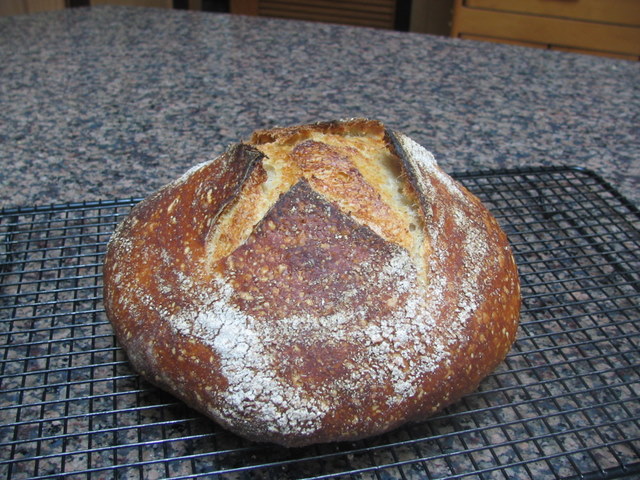I blogged on a similar sourdough last year, but this is a slightly different version, with a bit of semolina and whole wheat flour. I baked this bread for a very special occasion, the visit of dear friends I had not seen in 15 years! A cute story behind our friendship needs to be told. Back in 1995. When I moved from Paris to Norman to join the University of Oklahoma, a colleague from our department insisted I should meet Denise, a Brazilian graduate student from the College of Education. It so happens that I’m not that wild about this type of arranged meeting. I don’t know exactly why, maybe I simply prefer to meet people naturally and make connections independently of the place where they were born. And guess what? Denise felt exactly like me about the whole thing. But we both liked that Professor very much, and decided what the heck, let’s just give this a try. To make a long story short, we “clicked” in a way that we could not have anticipated in a million years! Our friendship continued after she, her husband Hélio and three kids (now three adults) emigrated permanently to England a few years later. Hélio now travels to Texas on a regular basis for work, and that made it easier for them to plan a quick visit to our neck of the woods. Fifteen years! Hard to believe time passed so quickly… Denise loves cranberries, so this bread was a natural choice to welcome them to our home. She also loves white chocolate, but that story shall be left for another post…
DENISE’S SOURDOUGH WITH CRANBERRIES AND WALNUTS
(from the Bewitching Kitchen)
For the starter (you won’t use everything)
30 g sourdough starter (at 100% hydration)
55 g water
45 g all-purpose flour
For the dough:
65 g starter (about half of starter prepared)
220 g water
160 g semolina flour
120 g bread flour
35 g whole wheat flour
7 g sea salt
80 g dried cranberries
50 g toasted walnut pieces
Make your starter 12 hours before you intend to prepare the dough. Let it ferment at room temperature.
To the appropriate amount of starter (65 g, remember you are not using the full amount made) add the water and mix gently to dissolve it. No need to completely dissolve the starter at this point. Add the flours and mix, allow it to sit with the water for 30 minutes at room temperature.
Sprinkle the salt over the dough, mix it by folding several times, to incorporate the salt. Add the cranberries and the walnuts, mix them gently. Allow the dough to ferment for 5 hours. Fold 5 times at 30 minute intervals. That will take you to 2.5 hours fermentation. Allow the dough to ferment for 2.5 more hours undisturbed.
Shape the dough as a ball, place it in the fridge overnight. Remove it from the fridge one hour before baking, as you heat the oven. Invert the shaped loaf on a baking sheet covered with parchment paper for easy transfer to the oven.
Bake at 450 F with initial steam for 20 minutes, reduce temperature to 425 F and bake for about 25 more minutes. Use your favorite method to generate steam, I like a covered Dutch oven with the lid moist with water before covering the bread. After 30 minutes I open the lid to allow the bread to brown. Cool completely on a rack before slicing.
ENJOY!
to print the recipe, click here

Comments: I am always a bit anxious when it comes to baking bread for special friends. I want it to be perfect, delicious, awesome, but sourdough is a harsh mistress… You can make one perfect loaf, use the same starter, the same recipe a couple of days later and open the oven to find a bread that turned out more like a flat pancake. Usually still very tasty, but… well, you get my point. I made this bread the day before they arrived, so that if it was not worthy of my friends, I could have time for a plan B: a frantic drive to the grocery store. Imagine that! But to my relief it all had a happy ending. A beautiful marriage between cranberries and walnuts, nice balance of whole wheat with regular flour so that the bread itself had a nice texture and taste. Perfect with goat cheese, but even just a little butter will work well. Honestly, even naked it’s great. The bread. Obviously.
I am submitting this post to Bread Box Round Up,
hosted by Karen, the Bread Baking Goddess.
ONE YEAR AGO: Sichuan Pork Stir-Fry in Garlic Sauce
TWO YEARS AGO: Our Green Trip to Colorado
THREE YEARS AGO: Ditalini Pasta Salad
FOUR YEARS AGO: Celebrate Wednesday with a Thai Seafood Curry
FIVE YEARS AGO: Post-workout Breakfast
SIX YEARS AGO: Semolina Barbecue Buns
SEVEN YEARS AGO: Lavash Crackers




















